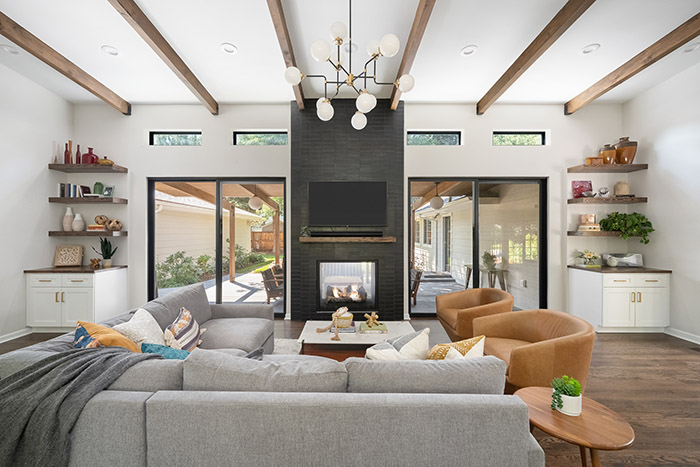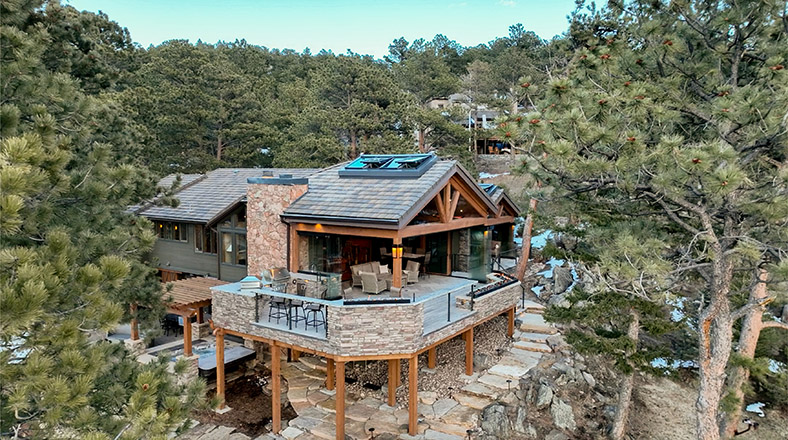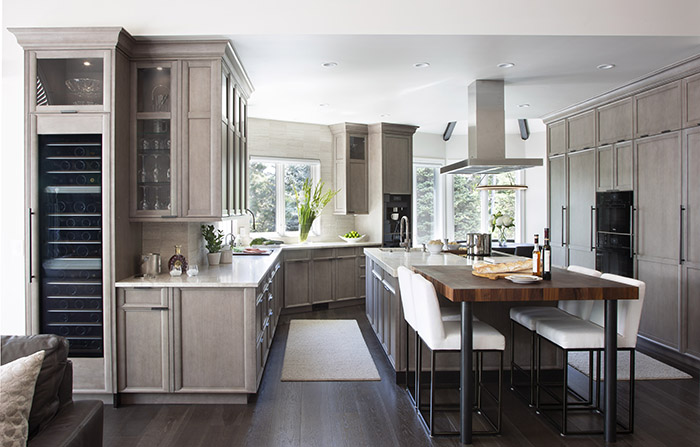By Heather Shoning
WHAT YOU NEED TO KNOW to turn your little slice of Centennial State heaven into a home perfectly suited to your family’s needs and design aesthetic

Photo by Spacekraft Media for Ascent Contracting
We are so lucky in the Denver metro area to have an array of high-quality, high-integrity companies to help us renovate our homes. And it’s a great time to invest in the home you have—not only to increase its market value, but also to increase its livability for you and your family. Let’s face it: That’s what really matters right up until the moment you decide you want to sell it, anyway.
If you’ve never done it before, tackling a large—or even a small—remodeling project can be daunting. Our aim is to help you work through some questions you might have, start thinking like a pro about your project and engage the right team to help you start it off on a solid foundation.
We have confidence that you can create the home of your dreams with its heavenly Colorado backdrop. And once you do, be sure you and your renovation team let us know! Maybe your home will be published in these pages soon!
These Professionals Weigh In
John Pavlakovich
Prosperity Home Mortgage
phmloans.com
Dawn Wilkinson
Six Walls Interior Design
six-walls.com
Justin Bride
Ascent Contracting
ascentcontractinginc.com
Joseph Nguyen
Dream Makers Landscape
dreammakerslandscape.com
The kitchen pros at
Kitchen Distributors
kitchendistributors.com
The appliance pros at
Mountain High Appliance
mountainhighappliance.com

Assemble Your Team
Whether you do this before, during or after you’ve secured funding for your project, it’s an important step that requires time. Many remodeling projects take a long time to produce, so you’re going to have a long relationship with the firm you select—you need to be sure you like the people on your team and that you trust them. You’re putting (probably) your most significant investment—your home—into their hands.
A referral from a friend or neighbor and seeing the workmanship is always a great place to start. Look for a contractor with a good reputation and extensive experience in the type of remodeling you need. Review the contractor’s portfolio to see examples of their past projects. This will give you an idea of their style, quality of work and whether they have experience with projects similar to yours. Always ask for references even if you have a referral. Legitimate and quality contractors should be able to invite you to tour past projects to see their workmanship and gauge their expertise.
Depending on the project scope, you may need an architect, engineer, contractor or builder, and an interior designer. Dawn Wilkinson, CEO and president of Six Walls Interior Design, stresses that homeowners should be aware that a renovation really is a team project. “One person isn’t responsible for making the entire project happen,” she says. “For instance, your general contractor’s job often does not include making decisions with you on selections of materials. But it is definitely their job to help build a budget for the construction.” A designer helps you make the selections, which in turn, makes the general contractor’s job easier, and it allows them to provide a more accurate budget based on a detailed binder of information from your designer.
Some firms handle everything in-house—sometimes called design-build—, others have a team of independent professionals who work together on projects, and some might just give you a short list of referrals. For instance, if you first engage an architect, he or she might do the architectural plans for you, then give you a list of a few contractors they know and trust. Then, the onus is on you to interview and select one. You might need to do the same thing if you need an interior designer, too. Either way of going about assembling your team is fine, just be aware that you might need to invest significant time in this process.
Another consideration to take into account when selecting your team is communication style. You are likely to have a lot of decisions to make throughout this process, and—especially if you haven’t done many renovations in your lifetime—you’re probably going to have a lot of questions and concerns. Make sure your team members are responsive, listen to your ideas and concerns, and communicate clearly about timelines, budget and any potential issues that may arise. But how will you know until it’s too late? This is a great topic to address with referrals and references.
Be sure your team members are properly licensed and insured and that your contractor is familiar with local building codes and regulations and will obtain any necessary permits for the project. Inquire about warranties—a reputable contractor should guarantee the work for a specific period of time, oftentimes one year. Finally, get everything in writing. A detailed contract should outline the scope of work, timeline, payment schedule and any other important terms and conditions.
Financing Options
Several factors go into determining the best financing option for a home renovation. As rates fluctuate, it’s important to consider whether it makes sense to use liquid capital or to borrow money, which is where a good lender comes in handy. John Pavlakovich of Prosperity Home Mortgage, a Berkshire Hathaway affiliate, mainly deals in primary and secondary mortgages, but the company has a division for home equity loans.
Pavlakovich says the easiest resource for funding a renovation is your home’s equity. He also indicates that equity is the fastest way to access the funds—it can be two to three weeks. So, how do you know how much you might be able to borrow? Pavlakovich explains, “You take the value of your home times eighty percent, then subtract any outstanding mortgages.”
A standard home equity loan uses the above calculation, and that’s how much you borrow and repay over a fixed term with a fixed interest rate. Similar to a home equity loan, a home equity line of credit—often referred to as a HELOC—functions more like a credit card with a revolving line of credit. You can borrow up to a certain limit, and you only pay interest on the amount you use.
Another financing option is a cash-out refinance loan. With this type of loan product, you can refinance your existing mortgage for a higher amount than what you owe and receive the difference in cash. This option allows you to access equity while also potentially securing a lower interest rate—based on rates at the time you take out the loan, of course. A good lender will help you sort out your options and steer you in the right direction. And getting prequalified will help you set realistic budget expectations for your renovation project.

What Are You Renovating?
Most of the time, homeowners commit to renovations because of a basic and very specific need. This kitchen is dated, dark and doesn’t function well. The kids are growing up and we need a separate space for them to have friends over and do homework. Mom can’t take care of herself the way she used to, so we need a suite for her to move into. The reasons are varied and unique to each family and home. But as a part of filling that singular need, you might also take advantage of the opportunity to increase the value of your home in ways you might not have considered. Justin Bride, owner of Ascent Contracting suggests looking at the neighborhood and specifically square footage of the homes around you. “I’m always a proponent of adding enough square footage to the project to make sure that the property value is in line with property values of similar homes or some of the better homes in the neighborhood,” he says. If your home is already one of the largest in your area, maybe it doesn’t make sense to add more space. But if it’s one of the smaller homes, an addition can give you a lot of bang for your buck.
Bride also suggests that items that create greater curb appeal are good investments. “That can include a fresh and attractive front façade of the house,” he says. “And that can often include new, large, dramatic windows. Sometimes that can include a new roof line, especially at the front porch. After the homeowner has checked the box for whether or not square footage is important, the next box to check off is curb appeal and providing an element of grandeur into the home.”
You might be thinking: Why would I be considering these things if I really just want a new kitchen? Well, if you’re making the investment of time and money, why not just do it once? When you’re spending well into six figures, which can be the price tag on a renovation in the Denver metro, leaving the front façade of the home untouched would be remiss. Additionally, consider the big-ticket items in your home that are possibly outdated.
“In the southern suburbs, it was very common in the eighties and nineties to put in wood windows that are possibly double pane, but they’ve probably exceeded their lifespan,” Bride says. “I’m sure all of the seals are starting to go out, the double-paned window panels are starting to get condensation.” Plus, window technology is much better today, so why not upgrade to something more efficient and better quality?
As you consider the project scope and your budget, it’s important to have a realistic understanding of project costs as well as how long a project might take.

The Design Inquisition
OK, it’s not really that intense, but your team should be trying to get to know you so they can learn about your design aesthetic, how you live and how you want to live in your home. Dawn Wilkinson, of Six Walls Interior Design, says engaging in conversation and gathering information in person helps both the homeowner and the designer establish their communication style. “It’s really critical from the very beginning so that they know that they can trust us with sensitive information,” she says. “When people are sharing what their budget is or what their lifestyle is in their home, that’s a lot of information, and they’re entrusting with us to be good stewards of it.”
During the onboarding process, the Six Walls team aims to learn as much as possible about family structure and dynamics and how the different people who live there currently—or those who may live there in the future—impact the decision-making process and also the design elements they might present to the homeowners.
As the conversation around design style, aesthetics, colors and more, gets underway, Wilkinson says her team finds homeowners generally fall into two camps. One client may love spending hours pinning inspiration photos, while for another it might be better for a designer to spend time with the client in his or her current home. Either way, one thing Wilkinson stresses is that it’s important for homeowners to share what they dislike as much as what they like. It creates an information amalgamation that makes is easier to decipher a client’s wishes. Communication—it’s key.
Budget and Timeline
As you can imagine, renovation projects run the gamut for both budget and timeline, but it’s important to have a realistic starting point. Remodeling Magazine puts out industry stats regarding project budgets in metros across the country in its Cost vs. Value Report. Many local high-end remodeling companies say the numbers are 5- to 10-percent lower than the projects they produce. The most recent numbers for the Denver metro area were released in 2021, and they say the average job cost for an upscale bathroom addition is slightly more than $100,000; an upscale major kitchen remodel comes in at more than $150,000; and an upscale master suite addition is more than $300,000.
A note about the process of defining your project and the cost: As you work through the design phase, you’ll have the opportunity to add and subtract elements of the project to “value engineer” it to fit your budget. Sometimes, homeowners exceed the “budget” after getting into the design phase and starting to deep dive into what’s really important. Just keep in mind what Justin Bride of Ascent Contracting says about meeting the value of area homes—you don’t want to overbuild for your neighborhood. Dawn Wilkinson, of Six Walls Interior Design, adds that scope creep—yes, it’s a real thing—can happen, and a good design professional will help highlight the areas of impact that extend beyond the originally considered area of work. A sightline from a shiny new kitchen with a newly opened floor plan into a living area with a dated fireplace feature wall can be cause to increase the project scope and, hence, the budget.
Establishing a contingency fund is a great solution to help meet budget creep. Oftentimes, your contractor will build a contingency into your project budget, knowing that these things occur regularly. Make sure you understand how much contingency is figured into your budget—if any.
Project timelines can be just as slippery as the budget. Your contractor will be able to set a realistic timeframe once the drawings and designs are finished. But remember that permitting and changes to the project once it’s underway will affect timelines. In recent years, we’ve also seen major disruptions due to supply chain issues. While much of this problem has subsided, there can still be residual effects of a backlog on certain materials. Be sure to ask your contractor how these issues might affect your project schedule.
Based on the scope and project timeline, you might need to move out of your home for a period or make arrangements to completely vacate some areas of your home. For instance, if you’re remodeling your kitchen, will you eat out every night? Do you have a refrigerator in another area of the home where you can at least have staples and snacks on hand? Do you have a friend or family member who will let you “borrow” their kitchen on occasion? Put a plan in place before the construction starts to eliminate headaches and to set clear upfront expectations for your family about how you will be dealing with this disruption to everyday life.

Photo Courtesy of Dream Makers Landscaping
Beyond the House
Thanks to our 300+ days per year of sunshine, (generally) mild temperatures and limited numbers of pesky bugs, Coloradans embrace indoor-outdoor living with the best of ʼem! If you’re fantasizing about turning your yard into something special, an outdoor project might be on your bingo card. An outdoor living area can significantly increase your home’s usable living space, providing room for alfresco dining, entertaining, family movie night and more. Additionally, it provides health benefits associated with being in connection with nature.
A renovated—or completely new—outdoor living area can be a sanctuary for relaxation and rejuvenation. Create a cozy seating area, add comfortable furnishings and incorporate elements like water features or a fire pit to create a tranquil oasis where you can unwind and enjoy entertaining and family time. Think about the way you want to use the space whether it be for hosting gatherings, barbecues, parties and other social events. Perhaps you just want expanded space for spending quality time with family and loved ones, playing games, having meals together or simply relaxing outdoors. Or maybe you’d like a nice spot for outdoor activities including gardening, yoga or other exercise. Maybe you want all of the above—and with proper planning and guidance, you can have it.
To experience the best of both worlds, homeowners are taking a hybrid approach to indoor-outdoor living. Joseph Nguyen, owner of Dream Makers Landscape, says he’s seeing many metro area residents opting for an upscale enclosed patio. “We’re building patio covers and full glass walls that you can fully open,” he says. “We use NanaWall—bi-folding doors that you open completely. They’re frameless, so they look really good.”
Nguyen says many of his clients have kids entering their teen years, and the parents want their home to be the hang-out spot for the kids and their friends. Those projects tend to include such things as sport courts, in-ground trampolines, pools and hot tubs, in addition to the outdoor living areas.
“We listen to our clients and whatever style they want—modern, traditional, transitional, mid-century—we can design it,” Nguyen says. “Many of our projects are designed and engineered. We have a standard—our projects are built to last.”
Your outdoor living spaces should be designed for you and the way you want to live outside—and inside—your home, but an added bonus to creating a really great outdoor space is increased property value. It adds curb appeal, improves the overall aesthetics of your home and makes it more attractive to potential buyers if you decide to sell in the future.
“You gain a lot of value, and you have your own sanctuary—it’s a place to wind down,” Nguyen says.
Kitchen Trends & Tips
According to home and design website, Houzz, of 2021 remodeling projects, kitchen renovations were the most popular and accounted for the highest budget. Homeowners invested 25 percent more in kitchen upgrades in 2021 than in 2020, and certainly the trend continues as the kitchen isn’t called the “heart of the home” for no reason. We love our kitchens. Here are some top Denver-area trends.
Kitchen Design Trends from THE designers at Kitchen Distributors
Cabinetry lighting has emerged as a top functionality trend, providing both practical illumination and aesthetic appeal. Integrated LED lighting within cabinets and drawers not only improves visibility but also adds a touch of sophistication to the kitchen environment. These subtle yet impactful lighting solutions enhance the overall ambiance while making it easier to locate items stored within cabinets and drawers.
Say goodbye to clutter. Hidden pantries are taking over. Concealed doors are being used to hide walk-in or cabinet-style pantries, maximizing storage space while maintaining a clean and organized kitchen.
The concept of work zones is taking center stage, offering a more flexible and practical approach to organizing cooking spaces. Here’s how work zones could be organized and what tasks typically belong in each one:
Preparation Zone:This area is dedicated to food preparation and often includes the countertop space adjacent to the sink. Key features may include a large, durable work surface for chopping, slicing and mixing ingredients, as well as storage for cutting boards, knives and other utensils. It’s essential to have easy access to water and adequate lighting in this zone.
Cooking Zone: The cooking zone revolves around the stove or cooktop and is designed for tasks such as sautéing, boiling and baking. Nearby storage for pots, pans and cooking utensils is essential for quick and convenient access. Ventilation is also critical in this zone to remove cooking odors and heat.
Storage Zone: This space encompasses cabinets, drawers and the pantry for storing dry goods, canned items, small appliances and cookware. Efficient organization and accessibility are key, with features such as pull-out shelves and adjustable dividers, maximizing storage capacity and usability.
Cleaning Zone:The cleaning zone centers around the sink and dishwasher. Ample countertop space adjacent to the sink allows for easy dishwashing and meal cleanup, while storage for cleaning supplies and trash and recycling bins should be conveniently located nearby.
Service Zone: The service zone functions as a secondary preparation area for serving meals, making drinks or assembling snacks. It may include features such as a beverage center, wine refrigerator or countertop space for setting up a buffet or coffee station.
Tip: When weighing the decision between remodeling an existing kitchen or building a new one, homeowners must prioritize several key factors. First, the existing space and layout play a crucial role in determining the extent of alterations possible. Remodeling projects often require working within the confines of the current structure, while building a new kitchen offers greater flexibility in designing the layout and cabinetry placement from scratch. Second, budget considerations are paramount. Remodeling the existing space may be more cost-effective due to utilizing existing infrastructure, but unexpected challenges can arise, impacting overall costs. Conversely, building a new kitchen allows for allocating budget towards custom cabinetry and premium materials without retrofitting constraints. Finally, functionality and lifestyle needs should guide the decision-making process. Remodeling offers the opportunity to address specific pain points or inefficiencies in the existing layout, while building new kitchen allows for a customized design tailored to suit the homeowner’s lifestyle preferences seamlessly.
No kitchen renovation would be complete without the latest in appliance technology.

Photo By Emily Minton Redfield
The pros at Mountain High Appliance share trends in essential KITCHEN APPLIANCES
Induction cooktops are hugely popular and have been in the Denver market for years, mainly because of its faster response and speed versus gas. Dual fuel is extremely popular because it gives you the best of both worlds with the gas cooktop performance and the electric oven performance.
The double appliance trend is strong in custom, luxury homes in the Denver area. We see trends for double refrigeration (refrigerator and freezers in the scullery kitchen or service pantry). The appliances in the main kitchen are for show and are nicely organized, while the appliances in the service pantry are the work horses. Some customers opt for the “professional” dishwasher in their service pantry which offer a quick (but loud) cycle. They are great for cleaning up after larger dinners or parties. Multiple ovens, ranges and wall ovens are popular for those that love to cook or have larger families and gatherings. Multi-use ovens with a traditional oven plus other modes of cooking—such as air fry and steam cooking—are gaining popularity for busy families.
Tip: When remodeling—especially if you’re not replacing cabinetry—the main consideration is making sure your dream appliance will fit and that you have the necessary utilities to it (i.e. gas or electric).


